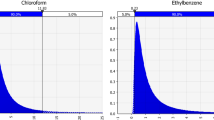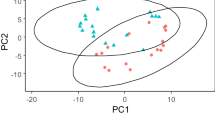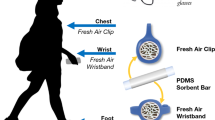Abstract
Innovative exposure measurement methods are needed for large environmental health studies, particularly for semivolatile organic compounds (SVOCs). Active air sampling methods are costly to implement, but passive air sampling presents a viable method. To expand and improve the use of passive air samplers (PAS) for indoor SVOC monitoring, we designed a unique, compact sampler using commercially available polyurethane foam (PUF) disks housed within durable, easy-to-setup, low-profile enclosures. We evaluated the new design using co-located active air samplers (AAS) and analyzed for SVOCs. Most of the targeted SVOCs found using active sampling (27 of 33) were also detected using passive sampling. We found good agreement (R2 = 0.88) between active and passive sampling methods for characterizing the relative abundance of each chemical, and the measured active sampler concentrations and passive sampler masses were significantly positively correlated for 14 of 21 chemicals, for which correlations could be estimated. We found that measurements of many SVOCs originating from consumer products and typically found in the gas-phase (log KOA < 10) can be reliably ranked—and thus appropriate for epidemiological studies—using this PAS design. These SVOCs include diethyl phthalate, AHTN, HHCB, tris(2-chloroethyl) phosphate, dibutyl phthalate, and tris(1-chloro-2-propyl) phosphate, as well as methyl paraben, benzophenone, and benzophenone-3, which have not previously been measured by passive sampling. This PAS can be used in epidemiological studies involving consumer product chemicals and complements other novel exposure tools.
This is a preview of subscription content, access via your institution
Access options
Subscribe to this journal
Receive 6 print issues and online access
$259.00 per year
only $43.17 per issue
Buy this article
- Purchase on Springer Link
- Instant access to full article PDF
Prices may be subject to local taxes which are calculated during checkout





Similar content being viewed by others
References
Rudel RA, Perovich LJ. Endocrine disrupting chemicals in indoor and outdoor air. Atmos Environ (1994). 2009;43:170–81.
Rudel RA, Camann DE, Spengler JD, Korn LR, Brody JG. Phthalates, alkylphenols, pesticides, polybrominated diphenyl ethers, and other endocrine-disrupting compounds in indoor air and dust. Environ Sci Technol [Artic]. 2003;37:4543–53.
Rudel RA, Dodson RE, Perovich LJ, Morello-Frosch R, Camann DE, Zuniga MM, et al. Semivolatile endocrine disrupting compounds in paired indoor and outdoor air in two northern California communities. Environ Sci Technol. 2010;44:6583–90.
Melymuk L, Bohlin P, Sanka O, Pozo K, Klanova J. Current challenges in air sampling of semivolatile organic contaminants: sampling artifacts and their influence on data comparability. Environ Sci Technol. 2014;48:14077–91.
Harrad S, Hazrati S, Ibarra C. Concentrations of polychlorinated biphenyls in indoor air and polybrominated diphenyl ethers in indoor air and dust in Birmingham, United Kingdom: implications for human exposure. Environ Sci Technol. 2006;40:4633–8.
Hazrati S, Harrad S. Calibration of polyurethane foam (PUF) disk passive air samplers for quantitative measurement of polychlorinated biphenyls (PCBs) and polybrominated diphenyl ethers (PBDEs): factors influencing sampling rates. Chemosphere. 2007;67:448–55.
Bohlin P, Audy O, Skrdlikova L, Kukucka P, Vojta S, Pribylova P, et al. Evaluation and guidelines for using polyurethane foam (PUF) passive air samplers in double-dome chambers to assess semi-volatile organic compounds (SVOCs) in non-industrial indoor environments. Environ Sci Process Impacts. 2014;16:2617–26.
Wilford BH, Harner T, Zhu J, Shoeib M, Jones KC. Passive sampling survey of polybrominated diphenyl ether flame retardants in indoor and outdoor air in Ottawa, Canada: implications for sources and exposure. Environ Sci Technol. 2004;38:5312–8.
Zhang X, Diamond ML, Robson M, Harrad S. Sources, emissions, and fate of polybrominated diphenyl ethers and polychlorinated biphenyls indoors in Toronto, Canada. Environ Sci Technol. 2011;45:3268–74.
Melymuk L, Robson M, Helm P, Diamond DM. Evaluation of passive air sampler calibrations: selection of sampling rates and implications for the measurement of persistent organic pollutants in air. Atmos Environ. 2011;45:1867–75.
Venier M, Audy O, Vojta S, Becanova J, Romanak K, Melymuk L, et al. Brominated flame retardants in the indoor environment - Comparative study of indoor contamination from three countries. Environ Int. 2016;94:150–60.
Vykoukalova M, Venier M, Vojta S, Melymuk L, Becanova J, Romanak K, et al. Organophosphate esters flame retardants in the indoor environment. Environ Int. 2017;106:97–104.
Saini A, Okeme JO, Goosey E, Diamond ML. Calibration of two passive air samplers for monitoring phthalates and brominated flame-retardants in indoor air. Chemosphere. 2015;137:166–73.
Okeme JO, Yang C, Abdollahi A, Dhal S, Harris SA, Jantunen LM, et al. Passive air sampling of flame retardants and plasticizers in Canadian homes using PDMS, XAD-coated PDMS and PUF samplers. Environ Pollut. 2018;239:109–17.
Shoeib M, Harner T, GMW, Lee SC. Indoor sources of poly- and perfluorinated compounds (PFCS) in Vancouver, Canada: implications for human exposure. Environ Sci Technol. 2011;45:7999–8005.
Shoeib M, Harner T, Lee SC, Lane D, Zhu J. Sorbent-impregnated polyurethane foam disk for passive air sampling of volatile fluorinated chemicals. Anal Chem. 2008;80:675–82.
Gale RW, Cranor WL, Alvarez DA, Huckins JN, Petty JD, Robertson GL. Semivolatile organic compounds in residential air along the Arizona-Mexico border. Environ Sci Technol. 2009;43:3054–60.
Petty JD, Huckins JN, Zajicek JL. Application of semipermeable membrane devices (SPMDs) as passive air samplers. Chemosphere. 1993;27:1609–24.
Strandberg B, Gustafson P, Soderstrom H, Barregard L, Bergqvist PA, Sallsten G. The use of semipermeable membrane devices as passive samplers to determine persistent organic compounds in indoor air. J Environ Monit. 2006;8:257–62.
Woolfenden E. Sorbent-based sampling methods for volatile and semi-volatile organic compounds in air. Part 2. Sorbent selection and other aspects of optimizing air monitoring methods. J Chromatogr A. 2010;1217:2685–94.
Woolfenden E. Sorbent-based sampling methods for volatile and semi-volatile organic compounds in air Part 1: Sorbent-based air monitoring options. J Chromatogr A. 2010;1217:2674–84.
Newton E, Rudel R. Estimating correlation with multiply censored data arising from the adjustment of singly censored data. Environ Sci Technol. 2007;41:221–8.
Dodson RE, Udesky JO, Colton MD, McCauley M, Camann DE, Yau AY, et al. Chemical exposures in recently renovated low-income housing: influence of building materials and occupant activities. Environ Int. 2017;114–27
Gorecki T, Namiesnik J. Passive sampling. Trends Anal Chem. 2002;21:276–91.
Anderson KA, Points GL 3rd, Donald CE, Dixon HM, Scott RP, et al. Preparation and performance features of wristband samplers and considerations for chemical exposure assessment. J Expo Sci Environ Epidemiol. 2017;27:551–9.
O’Connell SG, Kincl LD, Anderson KA. Silicone wristbands as personal passive samplers. Environ Sci Technol. 2014;48:3327–35.
Kile ML, Scott RP, O’Connell SG, Lipscomb S, MacDonald M, McClelland M, et al. Using silicone wristbands to evaluate preschool children’s exposure to flame retardants. Environ Res. 2016;147:365–72.
Dodson RE, Susmann H, Rodgers KM, Brody JG, Rudel RA. Crowdsourced and crowdfunded biomonitoring. International Society for Expsoure Science Annual Conference: Durham, NC; 2017.
Acknowledgements
This work was supported by the Swain Barber Foundation, U.S. Department of Housing and Urban Development (Grant No. MAHHU0005-12), and charitable contributions to Silent Spring Institute.
Author information
Authors and Affiliations
Corresponding author
Ethics declarations
Conflict of interest
The authors declare that they have no conflict of interest.
Electronic supplementary material
Rights and permissions
About this article
Cite this article
Dodson, R.E., Bessonneau, V., Udesky, J.O. et al. Passive indoor air sampling for consumer product chemicals: a field evaluation study. J Expo Sci Environ Epidemiol 29, 95–108 (2019). https://doi.org/10.1038/s41370-018-0070-9
Received:
Revised:
Accepted:
Published:
Issue Date:
DOI: https://doi.org/10.1038/s41370-018-0070-9
Keywords
This article is cited by
-
Evaluation of ceiling fan dust as an indicator of indoor PCBs pollution in selected cities of Punjab, Pakistan: implication on human health
Arabian Journal of Geosciences (2022)



